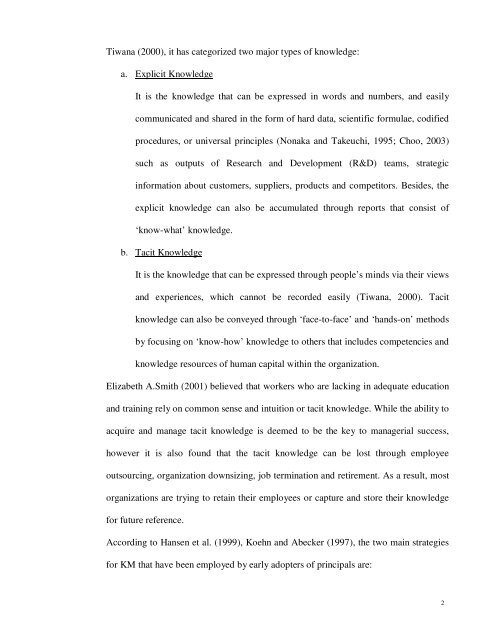1.0 Chapter 1: Introduction This chapter describes the ... - DSpace
1.0 Chapter 1: Introduction This chapter describes the ... - DSpace
1.0 Chapter 1: Introduction This chapter describes the ... - DSpace
You also want an ePaper? Increase the reach of your titles
YUMPU automatically turns print PDFs into web optimized ePapers that Google loves.
Tiwana (2000), it has categorized two major types of knowledge:a. Explicit KnowledgeIt is <strong>the</strong> knowledge that can be expressed in words and numbers, and easilycommunicated and shared in <strong>the</strong> form of hard data, scientific formulae, codifiedprocedures, or universal principles (Nonaka and Takeuchi, 1995; Choo, 2003)such as outputs of Research and Development (R&D) teams, strategicinformation about customers, suppliers, products and competitors. Besides, <strong>the</strong>explicit knowledge can also be accumulated through reports that consist of‘know-what’ knowledge.b. Tacit KnowledgeIt is <strong>the</strong> knowledge that can be expressed through people’s minds via <strong>the</strong>ir viewsand experiences, which cannot be recorded easily (Tiwana, 2000). Tacitknowledge can also be conveyed through ‘face-to-face’ and ‘hands-on’ methodsby focusing on ‘know-how’ knowledge to o<strong>the</strong>rs that includes competencies andknowledge resources of human capital within <strong>the</strong> organization.Elizabeth A.Smith (2001) believed that workers who are lacking in adequate educationand training rely on common sense and intuition or tacit knowledge. While <strong>the</strong> ability toacquire and manage tacit knowledge is deemed to be <strong>the</strong> key to managerial success,however it is also found that <strong>the</strong> tacit knowledge can be lost through employeeoutsourcing, organization downsizing, job termination and retirement. As a result, mostorganizations are trying to retain <strong>the</strong>ir employees or capture and store <strong>the</strong>ir knowledgefor future reference.According to Hansen et al. (1999), Koehn and Abecker (1997), <strong>the</strong> two main strategiesfor KM that have been employed by early adopters of principals are:2
















